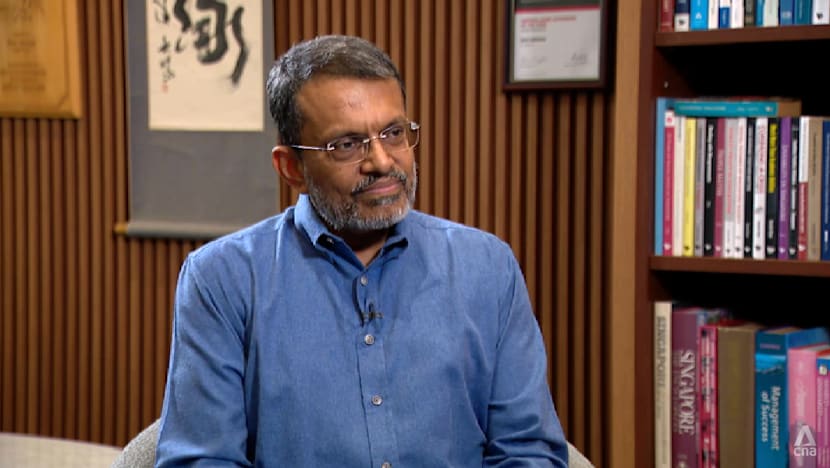Southeast Asia must step up efforts to attract climate finance, says Ravi Menon
The region has “quite a long way to go” in getting the investment needed for its energy transition, Singapore’s Ambassador for Climate Action tells CNA’s Sarah Al-Khaldi.

Singapore’s Ambassador for Climate Action Ravi Menon speaks to CNA during an interview.

This audio is generated by an AI tool.
SINGAPORE: Southeast Asian nations still lag behind other markets in attracting funds to finance climate projects, especially in technology solutions tailored to their geography and economic development, said Singapore’s Ambassador for Climate Action Ravi Menon.
“There’s quite a long way to go in Southeast Asia,” said Mr Menon, who is also the former managing director of the Monetary Authority of Singapore (MAS).
He was speaking to CNA in a wide-ranging interview in conjunction with this year’s COP30 summit in Brazil, which kicked off on Monday (Nov 10), as well as the Singapore FinTech Festival that opens on Wednesday.
Mr Menon noted that over the past decade, private financing for climate projects worldwide has risen by “about 60 per cent, but Southeast Asia has not been getting much”.
“A lot of the financing is going to advanced economies, (and a) growing proportion … is now going to large, regionally emerging economies like India or China and parts of Latin America.”
The challenge, he said, is to build financial structures and incentives that draw capital to where it is most needed.
FINANCING CLIMATE TRANSITIONS
Mr Menon said he believes new financing models will be essential to bridge the gap.
He pointed to the Financing Asia’s Transition Partnership (FAST-P) – a Singapore-led blended-finance platform that uses public funds to draw in private capital.
For example, every dollar of public capital might bring in about four dollars of private capital, he said, “so you can create a much larger balance sheet to sustain transition projects in the region”.
Singapore is also pushing ahead on carbon markets, which Mr Menon described as a powerful tool for channelling money into decarbonisation projects.
“When (companies) buy carbon credits, you are making possible decarbonisation in an emerging market or a developing country where they don't have the necessary financing to carry on the transition project,” he said.
SINGAPORE AS REGIONAL CATALYST
In the region’s climate funding efforts, Mr Menon sees Singapore’s role as that of a facilitator and partner.
With its strong financial sector, carbon-services hub and ongoing work on clean technologies such as carbon capture, hydrogen, biofuels and agri-tech, Singapore is well placed to support Southeast Asia’s transition.
“It is about making ourselves useful and relevant to the needs of Southeast Asia and to channel some of this financing towards projects there,” he said.

TAKE COP30 GOALS SERIOUSLY
Looking to the United Nations Climate Change conference (COP30), Mr Menon said the focus must be on stronger national commitments to curbing emissions.
Not all of the 11-member Association of Southeast Asian Nations (ASEAN) submitted their updated 2035 climate targets, he noted, expressing hope for more to do so.
“That will send a strong signal that we are serious, that we have firm targets, and that will help to draw investments and capital into the region,” he explained.
He added that Brazil’s emphasis on forests and nature-based carbon removal is applicable to Southeast Asia, noting that deforestation is the second-largest source of emissions in Asia after coal-fired power plants.
“Solutions for deforestation and technologies for meaningful reforestation, restoration, mangroves, peatlands … those are very relevant for Southeast Asia,” he said.
“We hope greater attention on these issues at COP30 will also help Southeast Asia address some of its climate challenges.”
A DECADE OF FINTECH EVOLUTION
As the Singapore FinTech Festival marks its 10th anniversary, Mr Menon, who is now chairman of the Global Finance & Technology Network, was also asked to reflect on how far the country’s financial technology sector has come.
What began as a handful of start-ups and pilots has blossomed into a global innovation hub, he recounted.
The first wave centred on payments and national digital infrastructure such as Singpass, MyInfo and PayNow, which created the foundations for a digital economy.
Singapore’s Fintech movement over the past 10 years has been about the “collaboration within the ecosystem to bring about all these developments, and to enable them to function through e-commerce and other platforms”, Mr Menon added.
“For the next 10 years, we will see an expansion of multilateral digital payment systems, more connectivity (and) faster settlement times.”
Another wave was asset tokenisation, which involves converting ownership rights of a real-world or financial asset into digital tokens on a blockchain. This concept still has a long way to run, Mr Menon noted.
He said that the recent crypto downturn has made the industry more aware of its risks even as its potential remains strong.
The challenge now, he added, is to “figure out the good from the bad”, managing the risks of private cryptocurrencies while developing stablecoins and central bank digital currencies that could make the financial system more efficient and resilient.
ARTIFICIAL INTELLIGENCE, QUANTUM COMPUTING
Artificial intelligence is also spreading across financial services, not just in generative content but in deep-learning systems for risk management, portfolio optimisation and fraud detection, Mr Menon said.
Digital banks already rely on AI for credit evaluation, but Mr Menon sees its greatest potential in tackling financial crime such as money laundering.
“If you can train models well to detect patterns of behaviour that are indicative of money laundering risks, I think that would be a very powerful use case,” he said.
On quantum computing, Mr Menon said the technology is in its early stages and has the potential to solve complex problems far beyond what is currently possible.
At the same time, he warned, its ability to break encryption poses significant security risks that the financial system must prepare for.
GUARDING AGAINST NEW RISKS
Singapore has made major strides in areas such as scam prevention with tighter controls and greater coordination between central banks, regulators and enforcement agencies.
The goal, Mr Menon stressed, is to strike the right balance between safety and convenience.
“If we overdo the controls, we will be back to the old days where payments (were) such a pain,” he said.
Mr Menon likened the evolution of digital payments to the early days of the automobile, when safety measures were gradually introduced after many accidents.
He said that financial institutions must make payments just as secure – with the digital equivalent of seat belts, traffic signs and rules – so it is “mostly safe” for everyday users.
“As with everything we've dealt with in the last 10 years on the technology front, it's all double-edged,” he added.
“No reason to avoid them, but I think it should give us caution in how we harness the benefits and how we manage those downsides.”




















